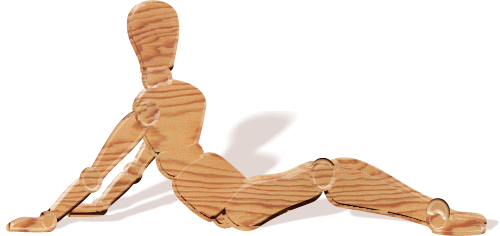Building a Marionette
It's easy to build your kids a lovely marionette.


Don't bother clicking on the mouse-over buttons, since they all point to this page! On a real site, they would point to generic tips about each of the topics. There's quite a bit of code involved in making this kind of navigation tool, and it's a mixture of HTML and JavaScript. Here's what the code looks like...
<!-- Navbar def -->
<script language="JavaScript">
<!-- Dummy comment to hide code from non-JavaScript browsers.
if (document.images) {
Button1MouseOff = new Image(); Button1MouseOff.src = "Button1.gif"
Button1MouseOver = new Image(); Button1MouseOver.src = "Button1MouseOver.gif"
Button1MouseDown = new Image(); Button1MouseDown.src = "Button1MouseDown.gif"
Button2MouseOff = new Image(); Button2MouseOff.src = "Button2.gif"
Button2MouseOver = new Image(); Button2MouseOver.src = "Button2MouseOver.gif"
Button2MouseDown = new Image(); Button2MouseDown.src = "Button2MouseDown.gif"
Button3MouseOff = new Image(); Button3MouseOff.src = "Button3.gif"
Button3MouseOver = new Image(); Button3MouseOver.src = "Button3MouseOver.gif"
Button3MouseDown = new Image(); Button3MouseDown.src = "Button3MouseDown.gif"
Button4MouseOff = new Image(); Button4MouseOff.src = "Button4.gif"
Button4MouseOver = new Image(); Button4MouseOver.src = "Button4MouseOver.gif"
Button4MouseDown = new Image(); Button4MouseDown.src = "Button4MouseDown.gif"
}
function turnMouseOff(ImageName) {
if (document.images != null) {
document[ImageName].src = eval(ImageName + "MouseOff.src");
}
}
function turnMouseOver(ImageName) {
if (document.images != null) {
document[ImageName].src = eval(ImageName + "MouseOver.src");
}
}
function turnMouseDown(ImageName) {
if (document.images != null) {
document[ImageName].src = eval(ImageName + "MouseDown.src");
}
}
// End of dummy comment -->
</script>
<center>Click on the buttons, below, to get get some great tips for your project.<br>
<table name="XaraTable" border="0" cellpadding="0" cellspacing="0">
<!-- shim row--><tr><td><img src="shim.gif" width="16" height="1" border="0"></td>
<td><img src="shim.gif" width="114" height="1" border="0"></td>
<td><img src="shim.gif" width="9" height="1" border="0"></td>
<td><img src="shim.gif" width="114" height="1" border="0"></td>
<td><img src="shim.gif" width="9" height="1" border="0"></td>
<td><img src="shim.gif" width="114" height="1" border="0"></td>
<td><img src="shim.gif" width="9" height="1" border="0"></td>
<td><img src="shim.gif" width="114" height="1" border="0"></td>
<td><img src="shim.gif" colspan="2" height="1" border="0"></td>
</tr>
<!-- Row 1 --><tr>
<td rowspan="2"><img name="r1c1" src="r1c1.gif" width="16" height="65" border="0"></td>
<td><img name="r1c2" src="r1c2.gif" width="114" height="20" border="0"></td>
<td rowspan="2"><img name="r1c3" src="r1c3.gif" width="9" height="65" border="0"></td>
<td><img name="r1c4" src="r1c4.gif" width="114" height="20" border="0"></td>
<td rowspan="2"><img name="r1c5" src="r1c5.gif" width="9" height="65" border="0"></td>
<td><img name="r1c6" src="r1c6.gif" width="114" height="20" border="0"></td>
<td rowspan="2"><img name="r1c7" src="r1c7.gif" width="9" height="65" border="0"></td>
<td><img name="r1c8" src="r1c8.gif" width="114" height="20" border="0"></td>
<td rowspan="2"><img name="r1c9" src="r1c9.gif" width="21" height="65" border="0"></td>
<td><img src="shim.gif" width="1" height="20" border="0"></td></tr>
<!-- Row 2 --><tr>
<td><a href = "StartHere.htm" onmouseover="turnMouseOver('Button1')" onmouseout="turnMouseOff('Button1')" onmousedown="turnMouseDown('Button1')"><img name="Button1" src="Button1.gif" alt="" width="114" height="45" border="0"></a></td>
<td><a href = "StartHere.htm" onmouseover="turnMouseOver('Button2')" onmouseout="turnMouseOff('Button2')" onmousedown="turnMouseDown('Button2')"><img name="Button2" src="Button2.gif" alt="" width="114" height="45" border="0"></a></td>
<td><a href = "StartHere.htm" onmouseover="turnMouseOver('Button3')" onmouseout="turnMouseOff('Button3')" onmousedown="turnMouseDown('Button3')"><img name="Button3" src="Button3.gif" alt="" width="114" height="45" border="0"></a></td>
<td><a href = "StartHere.htm" onmouseover="turnMouseOver('Button4')" onmouseout="turnMouseOff('Button4')" onmousedown="turnMouseDown('Button4')"><img name="Button4" src="Button4.gif" alt="" width="114" height="45" border="0"></a></td>
<td><img src="shim.gif" width="1" height="45" border="0"></td></tr>
<!-- Row 3 --><tr>
<td colspan="9"><img name="r3c1" src="r3c1.gif" width="520" height="20" border="0"></td>
<td><img src="shim.gif" width="1" border="0"></td></tr>
</table></center>
<!-- Navbar def end -->
All you need to do is select the code that you want to automate (in this example, it's the code you see, above) and save it as a separate file. Then, use JavaScript Maker to create a function from that code. To see how the function is used, click here.